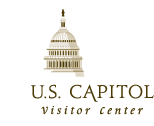Meeting the National Standards
A visit to the U.S. Capitol is a study in U.S. history, government, and civics. This learning experience also parallels students’ learning in the classroom about their immediate community and local and state history and government. This contrast-and-compare process helps students make connections to what affects them directly versus what is going on across the country—historically and currently. Study trips to museums, historic sites, monuments, and the Capitol expose students to art, artifacts, documents and people that bring the history alive, enabling students to better understand how the government serves its citizens and our responsibilities as citizens.
The learning experience at the Capitol Visitor Center enables students to practice skills in critical thinking and analytical interpretation to compare and contrast the beliefs, motives, traditions, hopes, and concerns of people from various groups and backgrounds and at various times in the past and present. A trip to the U.S. Capitol supports these learning skills, as well as the National Standards in U.S. History, Civic Education, Social Studies, and Fine Arts.
Our online exhibit, Building a More Perfect Union, includes pre-,during, and post- visit educational activities. Click here for more information.
National Standards for U.S. History
Elementary (K-4)
- Standard 4: How democratic values came to be and how they have been exemplified by people, events, and symbols.
- Standard 4A: Demonstrates understanding of how the United States government was formed and of the nation’s basic democratic principles set forth in the Declaration of Independence and the Constitution.
Middle and High School (5-12)
Era 3: Revolution and the New Nation (1754-1820s)
- Standard 3: The institutions and practices of government created during the Revolution and how they were revised between 1787 and 1815 to create the foundation of the American political system based on the U.S. Constitution and the Bill of Rights.
National Standards for Civics and Government
Elementary (K-4)
Content Standards
- Standard 1: What is Government and What Should It Do?
- Standard 2: What are the Basic Values and Principles of American Democracy?
- Standard 3: How Does the Government Established by the Constitution Embody the Purposes, Values, and Principles of American Democracy?
- Standard 5: What are the Roles of the Citizen in American Democracy?
Middle/High School (5-8 and 9-12)
Content Standards
- Standard 1: What are Civic Life, Politics, and Government?
- Standard 2: What are the Foundations of the American Political System?
- Standard 3: How Does the Government Established by the Constitution Embody the Purposes, Values, and Principles of American Democracy?
- Standard 5: What are the Roles of the Citizen in American Democracy?
National Standards for Social Studies
Grades K-12
Standard: Civic Ideals and Practices
- Understanding basic freedoms, rights, and the institutions and practices that support shared democratic principles as the foundations of a democratic republic.
- Civic ideals developed over centuries. In some instances, civic practices and their consequences are becoming more congruent with ideals, while in other cases the gap is wide and calls for continued civic action by individuals and groups to sustain and improve the society. Learning how to apply informed civic action to more fully realize civic ideals is of major importance for the health of individuals, groups, the nation, and the world.
National Standards for Fine Arts
Grades K-12
- Standard 1: Understanding and Applying Media, Techniques, and Processes.
- Standard 3: Choosing and Evaluating a Range of Subject Matter, Symbols, and Ideas.
- Standard 4: Understanding the Visual Arts in Relation to History and Cultures.
- Standard 6: Making Connections between Visual Arts and Other Disciplines
QuickLinks »
- Book a Tour
- Getting to the Capitol
- Tips for Visiting
- Prohibited Items
- Visitors with Disabilities
- Visitor Center Map
- U.S. Capitol Map
- Frequently Asked Questions
- For The Press
- Brochures
- Special Activities and Tours
- Exhibition Hall Cell Phone Tour
- Visiting the House and Senate Galleries


